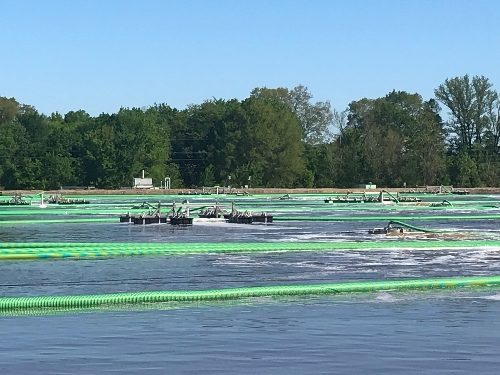A chemical plant in the gulf coast faced several challenges in their wastewater plant. They routinely experienced high-strength influent with TKNs as high as 450 mg/L and CODs of over 5,000 mg/L. This load required an actual oxygen required (AOR) for treatment often over 30,000 lbs./day, which resulted in high electricity costs. Further, variabilities in flowrate, strength, and the concentration of inhibitory compounds caused inconsistent nitrification performance. Entex was approached to determine how best to address these issues and fix their troubled lagoon.
The original aeration system for the facility consisted of coarse bubble diffusers weighted with concrete blocks, all connected to an air header on the shore via submerged hoses. Over the years diffusers had broken, and hose connections had come loose. The plant had been closing off the air to laterals with damaged equipment since the maintenance crew could not access the equipment for repairs. As a result, an already inefficient system was steadily declining in performance and electricity bills were rising.
Entex replaced this aeration system with 18 OctopusTM floating modules. Each module has 32 fine-bubble diffusers located at an elevation of 1 foot above the lagoon floor. The switch from inefficient coarse to efficient fine bubble aeration reduced the air flow, and thus the electricity cost for the same level of treatment by about 40-50%. Furthermore, with the Octopus system, the airlines themselves and all connections are above the water line for easy access and maintenance. The diffusers can be easily inspected, repaired, or replaced by disconnecting a camlock quick connect to any of the module’s 8 legs and lifting just that leg out of the water to be serviced on shore.
Entex also helped to increase the consistency of the nitrification performance by installing 12 WebitatTM attached-growth, fixed-film modules. The high-surface area of the BioWeb media is a preferred environment for nitrifying organisms relative to the bulk liquid. Installing the Webitats significantly increased biological surface area, and therefore nitrification capacity. Just as important, the biofilm on the media withstands injury from inhibitory or toxic substances better than suspended biology, reducing the impact of these events on treatment. Webitat modules can either be installed on the floor of lagoons or outfitted with floatation brackets. Since this facility had concrete blocks and other debris on the floor, a floating installation was chosen.
As this installation was reaching its one-year anniversary, the chemical plant upstream both increased production rates and introduced a new product, resulting in substantially increased load to the wastewater plant over the original Entex design. In response, 6 additional Octopus modules were installed to supply additional oxygen. This highlights one of the benefits of using Entex’s floating, modular systems. Adding additional capacity in the future is simple and straight forward.
If you would like an evaluation of the how Entex’s Octopus system and/or Webitat system can improve operations at your facility, contact us at info@entexinc.com.
